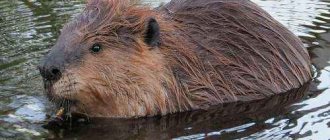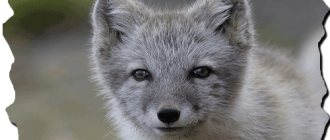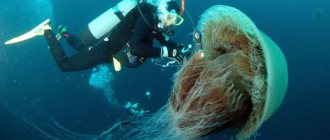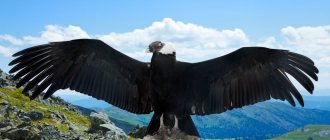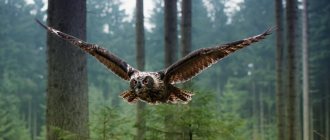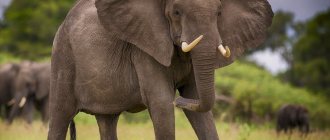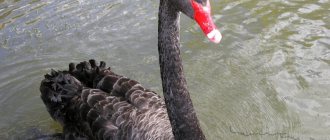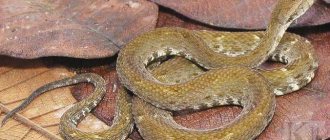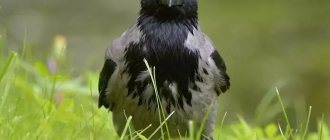A hawk is a bird of prey from the hawk family. This is a very skilled hunter with keen eyesight.
The size of the hawk is relatively small; the largest goshawks weigh up to 1.6 kg and have a body length of up to 68 cm. It is quite easy to distinguish it from other birds of prey: by its variegated coloring, and in flight by its wide wings and rounded tail.
The cries of a hawk “kiya”, “ki-i-ki-i” or “ki-ki-ki” also cannot be confused with any other bird once heard. The name “hawk” most likely comes from the Proto-Slavic roots “str” - fast, swift, and “reb” - motley, pockmarked.
Description of the bird
Hawk - a rare close-up photo
Size
Female hawks are usually larger than males, and their weight reaches 2 kg with a body length of 60 to 65 cm and a wingspan of more than 1 m. The weight of males usually ranges from 650 to 1150 g, respectively, and their body length and wingspan less.
What does it look like
— Advertising —
All hawks are characterized by wide and short rounded wings. The bird is also characterized by white “eyebrows”, which are located above the eyes and connect at the back of the head.
Color
There are many color options for the plumage of hawks, with blue, brown, black and white predominant colors. Sometimes completely jet-black hawks are found.
Hawks have large eyes with red or dark brown irises, and yellow legs.
Detachment "Birds of Prey": the Secretaries family
The Secretary class of the "Birds of Prey" squad consists of only one species!
- Secretary Bird
A bird of prey on the dry highlands of Africa, alone in its class of Secretaries and as a living bird of prey of terrestrial habits. Belongs to the category of Yatreboiformes. This is a long-legged bird with a thin but powerful body 1.2 m long and a wingspan of up to 2.1 meters. The weight sometimes reaches 4 kg. What makes it different is the black comb feathers, which are very similar to the quill pens that secretaries once used. She has a light gray body, black thighs, and white wing lining. Its tail has a pair of long central streamers. It mainly feeds on snakes and lizards, but also eats mammals and even insects.
Snake eater
What does it eat?
The hawk caught the dove
- Advertisement -
Hawks are birds of prey that feed mainly on animal foods. Chicks and young individuals eat larvae, insects, frogs and small rodents. As they grow older, hawks begin to hunt large prey such as pheasants, hazel grouse, squirrels, hares, and rabbits.
Hawks hunt during daylight hours, once every two days, since they have a special “bag” in their stomach, in which part of the caught and eaten prey is stored, and from there it gradually enters the stomach.
Hawks are known for their excellent vision; while soaring in the sky, they look out for prey at distances of several kilometers. Having tracked down the prey, the bird rushes down with lightning speed and grabs it with its powerful tenacious paws. During the chase, the hawk concentrates on its prey to such an extent that it sometimes does not notice obstacles in its path, for example, a tree, a house or even a train.
Order “Birds of Prey”: the Skopin family
Daytime birds of prey of the Skopin family also remained in the person of only one representative.
- Osprey
This is a common predator of both hemispheres, quite large: with a length of up to 55-58 cm, weighing from 1200-14600 to 1600-2000 g. As a rule, females are larger. The wingspan, accordingly, varies from 145 to 170 cm. The color of the upper plumage is brown. But the head, neck and abdominal region are white. Around the neck you can see a necklace of dark spots. They are also characterized by the “makeup” of a concealer - a brown stripe of a dark shade runs from the eyes.
The eyes are yellow, in juveniles - orange. It feeds almost exclusively on fish, which takes up approximately 99% of the total diet. Ospreys tend to breed on cliff tops or other high points, such as power towers or light towers, in large nests that are used year after year. They are difficult to spot when they are hunting as they glide low over the water.
Fisherman
Where does it live?
Hawks are found in all corners of our planet. These predators are most common in North (up to Alaska) and South America, as well as in the mountains and forests of Eurasia. Small hawks live in Africa and Australia.
Hawks inhabit mainly old relict forests, since they are forced out of open areas by hunters who shoot them.
Order "Birds of Prey": American Vultures
Diurnal birds of prey of the American vulture class also have few species - only 7, most of which, unfortunately, have become extinct.
- California condor
A very rare species of large birds that can fly. Their weight range is from 7 to 14 kg, length up to 110-140 cm, and wingspan 240-305 cm. The diet is based almost exclusively on carrion. It has black plumage with white feathers on the inside, a head and neck without feathers, with folds. Around the neck is a collar of sharp, protruding feathers.
Condor
- Andean condor
This is the only representative of the monopolistic condor genus. One of the largest birds, in which the male is heavier than the female - up to 15 kg and 11 kg, respectively. The wingspan reaches 270-310 cm. It has a black color with former stripes on the wings and a white collar, which is larger in males, and a head without feathers.
Memorable appearance
- Royal vulture
The brightest of the representatives of this family. They also have a bald head and neck, but with bright growths and colors, the plumage is white with black edging on the wings and tail. The length can reach up to 85 cm, weight up to 4.5 kg, and wingspan up to 2 m. They feed on carrion, but also on fish, snakes, and mammals.
Bright
- Urubu vulture or American black catarrh
The plumage is black, only light in the lower part, the head and neck are bald and wrinkled, dark gray in color. It lives in North and South America in the tropical zone. It feeds on carrion.
Description
- Greater yellow-headed catarrh
Representative of South America. The plumage is black with green or purple highlights. The name was given for the bright yellow or orange coloring of the head.
Dimensions
- Lesser large-headed catarth
Representative of Central and South America. They feed on carrion.
Dimensions
- Turkey Vulture
Bird of prey of North and South America. It has a very small red head, black-brown plumage, and wings with a gray-silver tint.
Vulture
The order "Birds of Prey" are special birds that evoke both fear and admiration at the same time. They look graceful and majestic, but they can be dangerous.
Kinds
Goshawk (Accipiter gentilis)
Goshawk stalks prey on a tree
The largest species. Males weigh from 630 to 1100 g, body length reaches 55 cm, wingspan from 98 to 104 cm. Females are larger, their weight is from 860 to 1600 g, body length reaches 61 cm, wingspan is from 105 to 115 cm. Above the eyes The birds have wide and long white stripes that almost converge at the back of the head. The iris of adult birds is red or red-brown, while that of young birds is bright yellow.
The plumage is bluish-gray to black. The back, head and wing coverts are darker, the belly is light with gray transverse streaks. The tail is light gray with dark stripes. The upper body, head and wings of young individuals are brown, the chest is white with longitudinal brown stripes.
The species is distributed in coniferous and deciduous forests and in the mountains of Eurasia and North America.
Sparrowhawk (Accipiter nisus)
A sparrowhawk landed on a fallen tree.
A small feathered predator with short, wide wings, and a long tail. The body length of an adult male is from 29 to 34 cm, the wingspan is 59-64 cm. The female is slightly larger, up to 41 cm in length with a wingspan of 67 to 80 cm, and weighing from 186 to 345 g. Both males and females are feathered dark gray, occasionally with a bluish tint. There are pale gray stripes on the belly with a red tint. The iris is orange-yellow or reddish-orange. The female has a dark brown or grayish-brown back, and light yellow eyes.
It lives in temperate and subtropical regions of Europe. From cold regions, it migrates to the south or southeast to Asia for the winter. It lives in forests, near open areas.
Crested Hawk (Accipiter trivirgatus)
A crested hawk sits on a branch.
The body length of the bird is from 30 to 46 cm. Females are larger than males. There is a short comb on the head. The tail is long, the wings are wide and short. Males are dark brown in color. Females also have a brownish belly.
The species' habitat includes southern Asia (India, Sri Lanka, China, Indonesia, Philippines). It prefers to live in lowlands, tropical and subtropical warm areas.
Short-toed Hawk (Accipiter soloensis)
Short-footed hawk - photo
Body length ranges from 30 to 36 cm, females are larger than males. In appearance it resembles a small sparrowhawk, but without a transverse pattern on the belly and with short toes. Adult birds have black wing tips. The male's back is gray, his belly is white, his iris is red. The female has a red breast and a yellow iris. Young birds are feathered like females.
The species breeds in eastern China, the Korean Peninsula and the southern Primorsky Territory of Russia. Listed in the Red Book of Russia. A migratory species, it flies to Indonesia and the Philippines for the winter.
Madagascar hawk (Accipiter francesii)
The Madagascar hawk sits on a branch.
The body length of the species is 21-29 cm, the wingspan is from 40 to 54 cm. Females are larger. The back of the male is dark gray, the head is light gray. The gray tail is decorated with a black stripe. The belly is white with thin stripes of red-brown or brown color in the chest area and on the sides. The wings have a white border. Females are brown above, with thin dark brown stripes on the tail. The belly is light with streaks. The iris, cere and paws are yellow. And in young individuals with a greenish tint.
Endemic to Madagascar, where it lives in forests, forest savannas, as well as in parks, large gardens, and plantations. It is found at altitudes up to 2000 m above sea level.
Light Hawk (Accipiter novaehollandiae)
The white hawk tore apart its prey.
Body length is from 44 to 55 cm, wingspan is 72-101 cm. Males are much smaller than females in size. For the light hawk, white and gray morphs are distinguished. The plumage of the gray morph is from blue-gray to bluish-gray in the head, back and wings, the underside is white with dark transverse stripes on the breasts. Paws are white. The white morph is painted completely white. The irises of both morphs are reddish-orange or dark red, and the legs are yellow.
In young individuals of the gray morph, the iris and nape are brown, and stripes are pronounced on the chest and on the upper side of the tail.
The species' distribution range includes forests, rainforests, rivers and forest edges in the coastal regions of Australia and Tasmania.
Australian brown hawk (Accipiter fasciatus)
Australian brown hawk on a wasteland.
Inhabitant of the Fiji Islands. The bird has a gray head and brown neck. The belly is red with white streaks. Body length is from 45 to 55 cm, wingspan is 75-95 cm. Females are larger in size. The weight of a male reaches 220 g, for females it is 355 g.
Striped Hawk (Accipiter striatus)
Banded Hawk in its nest
The smallest hawk in North America. The body length of males is from 24 to 27 cm, for females from 29 to 34 cm. The wingspan is 53 - 65 cm. The weight of males is from 87 to 114 g, females - 150-218 g. The head is small and round in shape. The tail is short. The beak is dark, small, hook-shaped. The wings are short, rounded, dark below. The claws are large and sharp. The plumage is dark gray, the crown is black; the breast, belly and underwings are light, with dark red transverse stripes. Rainbow burgundy. Legs are yellow. The tail has transverse white stripes. Young birds have a brown crown, nape and back, and a yellow iris.
The bird lives in Mexico, Venezuela, and Argentina.
Cuban Hawk (Accipiter gundlachi)
Cuban hawk on a tree
The body length of the bird is from 43 to 51 cm. The breast is grayish-brown in color with dark longitudinal streaks. The undertail is white.
It is widespread in the west of Cuba and is on the verge of extinction.
Bicolor Hawk (Accipiter bicolor)
Two-colored hawk on tree branches.
It lives in most countries of South and Central America, at altitudes up to 1800 m above sea level.
Dusky Songhawk (Melierax metabates)
Dark song hawk in a thorn bush
Body length from 38 to 51 cm. The back, wings and head are dark gray, the chest and neck are light gray. The belly is grayish-white, striped. The tail feathers and tail are gray or black. The tail is white at the top. The beak is yellow with a gray tip. Paws are red.
The species lives in savannas and forests in Africa south of the Sahara.
Detachment “Day Birds of Prey”: photo and brief description of the Sokolin class
Diurnal birds of prey in the Falcon order contain 11 families and 60 species.
- Lesser kestrel (steppe)
This is a small predator of the Falcon species. The female differs from the male in size and color of plumage, so it is impossible to confuse them. The only similarities they have are their dark eyes framed in yellow and a strong beak. The male has a blue-gray head, a reddish-brown back, a light-colored underpart without a pattern, and the tail feathers are blue-gray edged with black. The female has a rusty brown back and rufous tail feathers that are covered with black stripes and edged with a white outline.
Listed in the Red Book of Russia!
Comparison
- Merlin
It belongs to the genus of falcons in North America and the northern latitudes of Eurasia, for example in Norway, Sweden, Finland, Iceland and Siberia. This is a fairly large bird, about 55-60 cm. Females and males look the same, but the female is larger and heavier by about 0.5-1 kg. Depending on the area of residence, their upper plumage varies from brownish-gray or with a blue tint to light gray; the abdominal region is always light. They have dark spots all over the body, the so-called mustache near the mouth opening is barely noticeable. The beak has a tooth characteristic of falcons, and the paws are yellow.
The population is declining!
Merlin
- Peregrine Falcon
Known for their speed, peregrine falcons are the fastest on the planet. Their vertical speed during diving is more than 300 km/h; during normal flight while hunting, they can reach 100 km/h. Females are larger than males. Body length ranges from 34-50 cm, male weight up to 750 g, females reach 1.5 kg. The wingspan is up to 1.2 m. Both sexes have slate-gray wings, back and hood with a black tint, and pale bellies marked with brown stripes.
The population is declining!
The fastest
Reproduction
Hawk eggs in a nest
Mating season
Hawks are monogamous birds, forming one pair for life. Sexual maturity is reached at the age of 1 year. The mating season begins in mid-spring or early summer, depending on the region of residence.
Nest
A pair of hawks occupies its own territory, up to three thousand hectares. The bird's nest is built in the thickets of old forests on tall trees, from 10 to 20 m above the ground.
Masonry
The female makes one clutch per year, which consists of 2-8 eggs. The incubation period lasts 30 days, both partners take part in incubation.
Chicks
A hawk feeds its chicks.
In the second month of life, young birds become completely independent and leave the parental nest.
The average lifespan of a hawk is from 15 to 20 years; in captivity, the bird can live longer.
Interesting Facts
The wingspan of an adult hawk can reach 1 meter
- The origin of the word hawk in different languages is associated with the definitions “sharp”, “sharp”, “fast”, “fast-flying”, which indicates the character and lifestyle of the bird.
- In many mythologies and legends of the peoples of the world, hawks, along with eagles, were considered messengers of the gods. The inhabitants of Ancient Egypt worshiped the image of a hawk, because they believed that its eyes were a symbol of the moon and the sun, and its wings symbolized the heavens. Slavic warriors placed the image of a hawk on their banners as a symbol of courage, power and absolute ruthlessness towards enemies.


